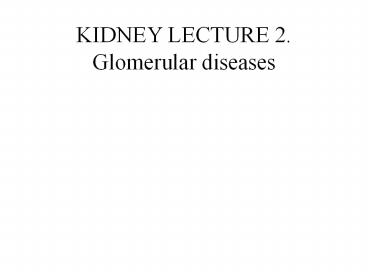KIDNEY LECTURE 2. Glomerular diseases - PowerPoint PPT Presentation
1 / 20
Title:
KIDNEY LECTURE 2. Glomerular diseases
Description:
KIDNEY LECTURE 2. Glomerular diseases Glomerular structure Arterioles Capillaries Mesangium ( between capillaries ) Urinary space surrounds glomerulus within ... – PowerPoint PPT presentation
Number of Views:252
Avg rating:3.0/5.0
Title: KIDNEY LECTURE 2. Glomerular diseases
1
KIDNEY LECTURE 2. Glomerular diseases
2
Glomerular structure
- Arterioles
- Capillaries
- Mesangium (between capillaries)
- Urinary space surrounds glomerulus within
Bowmans capsule
3
Glomerular structure - Mesangium
- Between capillaries
- Mesangial cells matrix
- Supporting framework
- Cell proliferation, produce matrix
- Contractile - directs local capillary blood flow
- Phagocytosis
- Cytokines - IL-1
4
Flow and filtration in glomerulus
- Blood enters by afferent arteriole -gt capillary
loops and exits by efferent arteriole - From blood in capillaries water small solutes
(lt70,000 kD) are freely filtered into urinary
space - This early urine -gt PCT and to rest of nephron
5
Glomerular capillary filter N.B. most blood in
capillaries returns to the circulation
- Blood in capillary lumen
- Part of endothelial cell with fenestrae (EN)
- Glomerular Basement Membrane (GBM)
- Epithelial cell foot processes (FP)
- Filtration slits, slit diaphragms nephrin
between FP - Urinary space
FP
EPI
GBM
Nephrin
RBC
EN
6
Normal glomerular filtration
- Filtration is relatively selective
- Size - water, small solutes lt 70,000kD
- Charge - GBM region is anionic e.g. GBM heparan
sulphate, epithel and endothel cell membrane
glycoproteins - thus, cationic molecules are more
easily filtered - Nephrin in slit diaphragms helps maintain
integrity of filter. Nephrin mutation -gt plasma
proteins leak through GBM and proteinuria. But
many other FP proteins also. - (Protein conformation)
7
Pathogenesis of glomerular disease
- Immunologically mediated
- A. Immune complex (commonest antigen often
unknown) - B. Anti-GBM (rare)
- C. Other immune mechanisms
- Activated T cells
- pauci-immune
- Non-immune - metabolic, vascular, hereditary,
other - Glomerular injury caused by
- Complement neutrophils, macrophages, O2 spec,
etc - Complement membrane attack complex (C5-C9) -gt
lysis - Cytotoxic antibodies, cytokines, O2 species, AA
metabs, N Oxide from glomerular or inflammatory
cells fibrin PDGF, TGFb
8
Immune complexes
- Immune complexes are granular deposits
(immunofluorescence) - Electron dense deposits (EM)
- GBM or mesangial
9
Anti-GBM antibodies
- Linear fluorescence continuously along GBM
- Not seen on EM
10
Two signs of glomerular disease - haematuria
proteinuria
- Haematuria
- RBCs in urine - microscopic and / or macroscopic
- (Normal GBM impermeable to RBCs, and no RBCs in
urine) - In certain glomerular diseases, RBCs -gt breaks in
GBM - (Other causes e.g. bladder, renal carcinoma)
- Proteinuria
- GBM,epithelial cell injury, (nephrin mutation,
altered FP proteins) - Loss of negative charge, loss of foot processes
- (Dipstick) 24 hour urine collection
11
Nephrotic syndrome, nephrotic-range proteinuria
Caused by excessive glomerular permeability to
protein - no protein in normal urine Nephrotic
syndrome Proteinuria gt3.5gm / 24
hrs Hypoalbuminemia Oedema - ankles, peiorbital,
etc Hyperlipidemia (low albumin -gt incr liver
synthesis of LDL, VLDL, and less breakdown of
lipoproteins)
12
Glomerular diseases
- Children usually primary - other organs
unaffected - Adults - primary or secondary glomerular disease
- Diagnosis combines clinical, serology, and
pathology - Renal biopsy
- Light microscopy - LM
- Immunofluorescence microscopy - FM
- Electron microscopy - EM
- Types of glomerular disease are descriptive
membranous, minimal change disease, IgA
nephropathy
13
IgA nephropathy
- Mesangial cell proliferation
- IgA immune complex deposits in mesangium, EM
deposits
14
IgA nephropathy
- Commonest glomerular disease worldwide
- Children, young adults MF 31
- Haematuria 1-2 days after (recurrent) respiratory
infection - Proteinuria variable serum IgA increased
- IgA immune complex deposits in mesangium,
mesangial cell proliferation - Inability to regulate mucosal IgA synthesis and
clearance in response to viral, bacterial or food
antigens - Alternate complement pathway - no C1q, C4
- Coeliac dis, dermatitis herpetiformis, liver
disease - Chronic course overall - 40 need dialysis,
transplant at 10 yrs
15
Minimal Change Disease
- Glomeruli normal on LM
- EM loss of foot processes
16
Minimal Change Disease
- Young children nephrotic syndrome
- Highly selective proteinuria
- Normal glomeruli by LM, FM
- Loss of foot processes on EM
- ? Factor secreted by T cells e.g. IL-8, TNF that
reverses GBM anionic charge by inhibiting nephrin
synthesis - Nephrin gene mutations in congenital nephrotic
syndrome - Responds to steroids, good prognosis
17
Membranous Glomerulonephritis
- Commonest primary glomerular cause of proteinuria
/ nephrotic syndrome in adults 30-50 yrs - Classic chronic immune complex disease
- Thick GBMembrane LM
- IC dense deposits and spikes on EM
- Fluorescent IC deposits on outer GBM
18
Membranous GN
19
Membranous GN
- EM deposits outer GBM
- Deposits dark, spikes pale
- FM Granular GBM deposits IgG also C3
20
Membranous GN
- Many known antigens
- Drugs, SLE, tumours, hepatitis B, but usually
idiopathic - Immune complexes deposited on GBM or form in situ
to intrinsic antigen - C5 -C9 Membrane attack complex -gt O2 species -gt
mesangial and endothelial cells, inhibiting
nephrin synthesis - Chronic renal failure and dialysis in 40 at 20
yrs also spontaneous remissions in 10-30. - Rx is controversial

